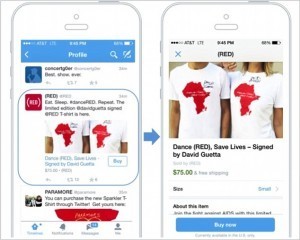Erik Qualman's Blog, page 573
January 13, 2015
How to Generate the First Customers for our New Online Startup?

At the time of starting –as also happened to us—, most of the founders of an Internet startup focus primarily on the server’s technology, database and graphic interface.
We really believe that, as our work is going to be brilliant, users will love to come by themselves.
Unfortunately this statement is far from reality; the discipline for thinking of a strategy in order to generate new customers is just as important to succeeding like any other aspect of business.
No matter how spectacular our online development is: unless we have visitors and customers, it is not worth it.
Next, I would like to share a step-by-step guide on how we did with our own business, which had 0 (zero) users at the beginning and which today has more than 21,500,000 customers in Latin America.
It is physical work.
Let’s first focus on understanding that Google, Facebook, Yahoo! and many others companies began just with one (1) single user, his first visitor (not a million of them.)
Then they started having a community of stakeholders, let’s say about 10, 20 or 50 of them, generally called “Early Adopters”. Those users are the ones that have a key effect on the future growth of the project; they will, by their own choice, spread the word.
At that early stage, we were in the first two steps as can be seen in the picture above.
I personally consider that those are the most important links and, what is more, they are the ones that pose more difficulty in any new startup.
It is fundamental to realize that this phase has as priority to understand our future customers and not thinking about how we are going to reach one million users.
Spending three months of our time in getting to know the typical customer was the first concrete step for us. That means that we showed them our development and sat beside them and watched as they used our system (without interrupting!). We pay attention to their reactions, questions, opinions, criticisms, and suggestions.
Though simple as it may seem, there is nothing that is more valuable than a face to face and personal experience with the potential clients. They could be family, friends, acquaintances or simply users that seem to have our development profile and agree to give us a few minutes of their time.
This first step shouldn’t be done by email, telephone or any other way which is not personal. As the famous entrepreneur Paul Graham said, “You have to leave the office in order to really meet clients.” I recommend following him on his blog, which is priceless: PaulGraham.com.
Use personal media.
Once we have spent three months in direct contact with customers, a process in which we were substantially improving our initial proposal as we learned from them (no one knows more about the customer needs than themselves!), we can move to the second step.
This second stage consist in taking advantage of our email box, Facebook and Twitter profile, in addition to any other media such as Whatsapp, and Line, among others.
It is important to highlight that I am not saying that making indiscriminate contact with an equal treatment is the best option (usually people realize and that subtracts value considerably); the message we want to transmit can be more or less the same in each case, but it must include the receiver’s name, and it must also be concise and personal. For example:
“Hi Diego,
We just finished developing a new online application that will help you find a cheaper travel ticket for holidays.
You can try it in the link that I sent you, and then you could, if you want, tell us your experience in order to continue improving the application. Your help is really valued for us Diego.
Thank you and have a nice day!”
The shorter the message, the better; I remember that we wrote a very long text for our website (as if it were a statement explaining even how the application worked in a technological way), we sent it and sincerely the results were very poor. After that we tested with two lines of text and it was substantially better.
Results measurement.
On this step of generating new customers, as in all the following ones, we cannot estimate how well or badly we are doing our job; from now on we need specific measurements.
For that reason I recommend using Google Analytics, which is a free tool, easy to install and use. It will help us to measure the traffic of people that access our site, their behavior and the end results.
For example, if our site is called www.mystore.com.ar, when we send a link, as we saw in the previous step, we can add a parameter (at the end of the URL we can add a question mark and some values) in order to know if this user does actually access our project and try it. Example with parameter: www.mystore.com.ar?usuario=diego
Also, if we want to know which media (facebook, twitter, whatsapp, to mention some) is generating better results, we can add another parameter with with & where we define value. For example: www.mystore.com.ar?usuario=diego&.... This is Diego, who came through Facebook.
It is not touch-and-go.
We should understand that maybe in the moment that we sent our message the user was in a meeting, on vacation or simply could not use our application, product/service at that moment.
That is why we must know who uses our service and who does not from the above mentioned step onwards. Being able to contact them with a very brief message to invite them again to try our development is important; it also valuable to ask for their opinion and criticism to continue improving.
“Hi Diego!
We are contacting you again in order to see if you want to help us with your experience and knowledge in this project that is very important to us through this link.
Since now we thank you Diego sincerely for your comments.
Thank you. “
You will be surprised by the answers that this second email may receive, as we continue contacting the user (friend, relative or acquaintance) by name and also monitor; demonstrating that his/her opinion is important to us. Just try it and you will be able to check it. Between the first and second email there has to be a period of 4 to 6 days’ time.
We should always thank the response to these emails.
Once we had performed the steps described in this article successfully, we continued by contacting different Media such as radio, television and newspapers. It was not easy. It took time, but the experience was worth it.
The following step was learning about SEO (Search Engine Optimization), which basically is like working with search engines (Google, Yahoo! and Bing) so that customers may find us when they seek for our service. For example, if we are offering an application that enables the client to find cheaper tickets, when someone searches “Cheap tickets to Mexico” in Google, our startup should appear in the search results.
Even today we continue working with SEO and I can say that that is one of the best ways to bet in the long term at Marketing level. Although there is not a solution to apply in the beginning of a venture in order to attract the first customers, which is why I do not mention this earlier in this note, it takes a lot of time: on average, about 2 to 3 years to see the first results; however, as a mid – long term strategy it is excellent. For more information I suggest using MOZ community, where you can find are interesting free videos and tutorials about this topic.
[image error]
January 9, 2015
Design a Social Media Plan for Home Improvements

We all know social media has exploded in recent years.
What started out as just a way to connect with friends has transformed into a way to keep up with local and world news, find a job, connect with people in your line of business and save money on everything from clothing and accessories to home improvement projects.
That’s right, social media can help you save money on your next home renovation or repair.
Setting One’s Self Apart From the Competition
First things first, if you’re in the construction or home remodeling business, you have to have social media pages for your business.
By utilizing Facebook, LinkedIn and Twitter at the very least, you will set yourself apart from your competitors. People want to see photos of your work, they want to read reviews and they want to see that you’ve made a name for yourself.
Social media shows that you’re professional and you take your business (and your customers) seriously.
If you’re a homeowner, social media can help you find the best products and services to meet your needs, all at an affordable price. Social media is free for you to use and can help you land the best deal on your home improvement projects and regular household needs.
The article “How much can you save?” discusses the benefits of cleaning your gutters regularly in order to prevent larger, more expensive problems down the line.
Social media can help you save money on both preventative maintenance needs and custom updates on your home.
Use social media for home improvement projects
Make sure you have a Facebook account and LinkedIn profile at the very least. Once your presence on social media is established, you can begin looking for ways to save money.
Tips include:
Follow your favorite companies – This includes both companies that sell products and companies that provide services. Most companies use social media to reach out to their followers when they’re offering discounts, specials or promotions. Keep a close watch on your favorite companies so you can make the purchase when the item is on sale.
Ask for recommendations – Perhaps an old college friend knows a great plumber or an acquaintance at an old job just started his own handyman business. Don’t be afraid to reach out on social media to find the best deal. If you’re installing new flooring, for example, you can post on Facebook that you’re looking for affordable flooring specialists in the area. Most likely, you will get at least a few helpful responses.
Participate in giveaways – What would social media be without giveaways? Companies like to hold giveaways in order to generate new business and keep their current customers. By entering a giveaway, you may just win a free kitchen remodel, free lawn care service for a year of half-off your favorite home décor items. Since it’s free to enter these giveaways, it’s always worth your time.
Look for DIY ideas – Pinterest is full of do-it-yourself home improvement projects and ideas. Scour the social media site and see if any of your projects can be done on your own. By avoiding the need to hire the work out, you can save thousands of dollars (and have some fun, too!).
Photo credit: Image courtesy of Naypong at FreeDigitalPhotos.net
[image error]
January 8, 2015
10 Social News Aggregators to Help You Reach New Audiences

You’ve written a blog, or added a social media post, or thrown an image onto Instagram … but what happens now? Do you just wait and hope to be found among the millions of messages bombarding the public every day? Of course not. That’s where social news aggregators come into play. These are handy-dandy platforms that assist you in getting the word out, whether it’s just for your pleasure or for serious business marketing.
Each aggregator in Internet-land helps people find your content by making connections between that content and similar items your friends, influencers, favorite news sites, etc., deem worthy of seeing and showcasing. The key is to make sure you’re choosing the right aggregator for your needs, and that’s why we’ve put together 10 of our favorites so you can determine which one will best fit the bill.
1. Reddit
Reddit is one of the kings of social news aggregators, allowing the most popular news to organically filter to the top using an algorithm based on shares and keywords. However, the nice aspect of Reddit is that you don’t need to make it to the first page in order to be seen. There are literally thousands of Reddit subtopics – yes, even one devoted to bacon – so you can drill down to the right audience. In order to share on Reddit, you have to create a free account, which takes about 10 seconds.
2. Hacker News
Hacker News is focused primarily on science and tech-related items, although occasionally a random topic will make its way through the ranks. Many of the posts focus on web technologies and programming, but you may see the occasional post about tuberculosis or astronomy. While it’s free to log in, it’s a very bare-bones platform that requires a little bit of finagling to get the hang of. Comments are big in Hacker News, so be prepared to contribute to the conversation. This will assist in getting more traction for the items you plug.
3. Inbound.org
For inbound marketers, this is the right place to find SEO and marketing advice. Plus, you can ask all the questions you have related to your given field. Again, registration and login is free, and will give you the opportunity to post to your heart’s desire. Just don’t be too in-your-face on Inbound.org. Inbound marketers aren’t looking to be sold to; they want true information and meaningful dialogue. Use this platform to set yourself up as an expert, not to necessarily woo clients right away.
4. GrowthHackers
After you log in to GrowthHackers, you’ll be able to sift through tons of marketing-related trending conversations and articles. If you’re in need of some advice when it comes to making your mark in your industry, this is the place to find it. Conversely, if you have advice to share, GrowthHackers is the social news aggregator to be.
5. BizSugar
BizSugar takes business sweetness to a new level by providing you with all the best business info that’s floating around the Web. You’ll find every topic from finance to management to technology, and you’ll be able to comment, vote and share. One caveat: You can’t submit your own content without registering.
6. Design Float
Web designers in search of serious pieces that relate to their profession will find Design Float to be a boon. As content is shared, it’s floated to the top of the first page. You can also search for specific information to help you cull through all the chatter. After logging in, you’ll be able to freely add your own Design Float submissions.
7. GOOD Community
Highlighting items that promote social good and the environment is the focus of GOOD Community. To become a strong presence here, you can easily register by linking your Facebook account, making it unnecessary to have a separate login for GOOD Community. (One less password to worry about, right?) Inspiring pieces, like this story about a homeless man who received $100 and used it to buy food for other homeless people, do very well here. If your intended audience is vegan, vegetarian, green and/or social justice minded, you’ll be able to reach them here.
8. Product Hunt
Product Hunt conveniently allows you to log in using your Twitter account, and then be able to spread news regarding great new projects and products that are available. Product Hunt’s collections allow you to peel back the layers of the proverbial onion and drill a little deeper for what you need.
9. Designer News
Want to learn everything that’s hot on the Web design stage? Register quickly at Designer News and you’ll be able to peruse a wide world of design-related stories and discussions. You can also post a design job for a monthly fee if you’re looking for a web design professional.
10. Blog Engage
Have a blog that isn’t getting you the traction you want? Try Blog Engage. Register and set up a login, and you’ll be prepared to start sharing. Plus, you can maximize your time on the site as a reader and a contributor by pinpointing your material within a narrower subject area, such as science, gaming and video blogging.
Of course, these aren’t the only social news aggregators available in cyberspace. Which ones do you like to use on a regular basis? Share your favorites in the comments below!
[image error]
January 7, 2015
5 Social Media Obstacles You Can Stop Worrying About In 2015

2015 is here, and with it comes a flurry of changes in the social media stratosphere. Whilst numbers of followers and page likes were once a key focus, now it’s all about engagement. Where maximum reach was a priority, our attention is currently shifting towards the right type of reach.
currently shifting towards the right type of reach.
As for keeping things organic…well, that’s rapidly becoming a thing of the past. And we don’t even need to feel guilty.
Here are five things to do with your social campaign that you can likely stop worrying about in 2015.
1. The Size of Your Audience
The number of followers or likes you have on your page no longer matters – what does is the proportion of active users regularly engaging with your brand. It is much better to have 2000 followers of which 50% are engaging, rather than have 10,000 followers of which only 5% are engaging. What matters above all is the relationship you build and share with your followers.
Whatever size your audience is so far, it’s important to keep interacting and striving to offer something of value to your followers regularly. This might be articles; simple Q&A advice, giveaways or discounts for your products. Virgin Media did this well when it launched its #socialmarathon campaign in 2011 – the day after the London marathon. Using the hashtag #ifvirgindid, it invited its audience to share their ideas for the company’s next big project.
It is this sort of interaction over time that will help build your audience and convert them into more dedicated customers.
2. Achieving Totally Organic Reach
With more and more platforms looking to monetize themselves, the concept of organic reach is receding further into the distance. Whilst it’s certainly still something businesses should aim for, social media managers will do well to remember that achieving fully organic reach at a high level is no longer that realistic. So throwing a bit of money into the pot isn’t something to be ashamed of.
Facebook has been trying to encourage companies to part with their money for some time, using the feature of ‘promoted posts’ to put their most important updates in front of a larger audience. Twitter later followed with its offer of ‘promoted tweets’ and later, even promoted accounts. At first glance it may seem like a pointless exercise, but these features allow brands to get their posts to specific audiences based on their interests and general browsing activity.
Companies should therefore see paid posts as an opportunity to delve into the nitty gritty of finding their target audience and capitalising on those who respond best. Trialling more than one campaign with different demographics is a good way to get a feel for one’s niche.
3. Getting Your Content Out to Absolutely Everybody
Similar to our earlier point about audience segmentation, getting your content out to absolutely everybody is no longer something you need to be bothered about. Not only can it lead to diluted content and often a convoluted mission as you try to please everybody; it’s also very unlikely your whole audience will engage how you want them to.
Major social platforms are now taking a more ‘interest based’ approach over ‘people based’. In the case of Facebook, the platform is continuously trying to improve the quality of users’ news feeds by only showing them content it thinks they’ll be interested in. This was determined via a new algorithm introduced in 2014, and users are now also invited to add ‘interests’ to their timelines so Facebook can show them more relevant content.
Twitter, Instagram and Pinterest meanwhile are proficient users of the humble hashtag, which helps users discover specific content, topics and discussions. Newer social platforms, meanwhile, such as Foodie and Fitocracy, are gearing themselves around a particular niche which unites users through a common interest.
So don’t afraid to be vigilant over who your content is best suited for and how. Rather than worrying about how to achieve a one-size fits all approach, take the steps to find your niche and get your content out to the right people.
4. Trying to Drive Conversions Via Web Links
The arrival of social shopping has opened the door to a new revolution for eCommerce brands on social media. Although still in the early trial phases on Twitter, Facebook and Tumblr, the concept has the potential to eliminate the dilemma of trying to convert followers to customers or drive them to your website via a status update.
With the humble integrated ‘Buy’ button, social shopping would make it much easier for followers to become customers and make more impulse purchases. Brands on Facebook and Twitter can make use of an already receptive audience who are regularly browsing the latest trends and keeping up with their friends’ updates. Ryan Holmes of TIME also shrewdly notes that the feature would help to forgo the ‘obsessive comparison’ shopping that dominates a lot of online purchases.
With the use of a secure third party payment platform like Twitter’s Stripe, users’ details will be kept on file making all future purchases just a click or tap away. Furthermore, it will enable companies to gauge exactly what proportion of their revenue comes from social updates alone.
5. Producing All of The Content Yourself
If you want to up your presence on any one social platform, it’s time to tap into the many benefits of consumer-generated content. Content that is created by your customers and fans not only takes some of the pressure off of your own team; it also builds stronger customer relationships and can offer valuable insight into their thoughts, opinions and ideas.
Consumer-generated content is the backbone of many Instagram and Twitter competitions, where users are asked to do something creative involving one of the brand’s products or simply talk about it in 160 characters. Consumer-made video is also a big hit – particularly if it involves the product directly, like GoPro’s Cool Videos contest. Vines are also highly popular due to its challenging 6-second concept.
Pinterest is also a great place for welcoming and prioritising consumer content, in the form of ‘brand advocates’ (otherwise known as ‘guest pinners’). Coca Cola also had its Tumblr followers liking, reblogging and posting their own creations with its ‘Happiness Is’ campaign.
Alternatively you could still create the content in-house, but use real-life customer stories to add an element of authenticity, like Starbucks’ ‘Meet Me at Starbucks’ campaign.
[image error]
6 Things I Learned from Avatar King & Entrepreneur Brett Durrett


Durrett's Avatar
Recently I was able to chat with IMVU CEO and entrepreneur Brett Durrett. Durrett is not your typical CEO; Durrett is a rockstar that can program video games. In fact, he was programming video games for companies before he was of legal age to sign a contract.
Today, Durrett is the dynamic leader of IMVU, the world’s leading 3D social network with over 130 million registrants and the world’s largest user-generated catalog of virtual goods with over 16 million items. Durrett is in great company, as Eric Ries (Lean Startup author) co-founded IMVU and is currently serving as a board observer.
Here are 6 critical items I learned from Durrett:
1. Solve for the First Penny
What’s the top piece of advice you give to entrepreneurs? Solving for the first penny is really hard. Many think about solving problems that aren’t really problems for people. They solve for things that won’t make a difference if they aren’t around in six months. Don’t make the mistake of trying to solve the two-year problems before solving the problems that exist in the next six months.
2. Stick with It
What’s Been Your Secret Sauce for Personal Success? Sticking with it. It’s far from easy starting a company and it is often too easy to quit. You need to stick with it. Being focused is key. Also, I’ve been fortunate. I’ve been lucky to work with great people. Success doesn’t happen alone.
3. Fail Fast: Go for Large Disruptive Pivots
Biggest failure and what did you learn? It’s hard to pick and not be biased by the most recent failures, which still have more sting than the older ones. One that comes to mind is my transition to CEO at IMVU. I was initially an interim CEO and then became CEO, so I had a very gradual transition. As a result, things I wanted to change at the company followed that gradual transition rather than a large, definitive pivot. In hindsight, missing a great opportunity to make a lot of big changes all at once slowed down progress. I believe it would have been better to have disruptive (and probably painful) changes all at once.
 4. People Meet & Marry via Avatars
4. People Meet & Marry via AvatarsWhat’s the mission of IMVU? Our mission is to allow people to meet through 3D avatars in a very easy and safe way. We allow people to reveal themselves on their own terms. Often our platform allows our users to relay their emotions when they might struggle to do the same thing in the offline world. Many of our members have gotten married after meeting in one of our virtual rooms. Ironically, they are meeting the “real me” through my avatar.
5. Avatars Save Lives
If IMVU went away tomorrow, what’s the loss to society? Some of our members are there for pure fun. Others want to meet new people in a stress free environment. We also over index with the LGBT community.
Often IMVU is a place for people to express their true self when their local community won’t be accepting. Many of our members feel they can’t be the “real me” in their offline community as they might get assaulted in real life. Our platform also allows for our creators to make a living. Customers create all of our content and items. Some of our customers are able to make a living purely on what they sell on IMVU. Most of the items are long-tail items: Asian facial look, hot dog characters, humanoids, and more. Our top sellers are always body customizations.
6. Mobile is the Future of Virtual Worlds
What has you the most excited right now? We are launching several new products in 2015 designed around rebuilding our product from being primarily PC Client and adapting for the mobile revolution. This will allow us to better customize avatars for everyone and also help our customers continue to build and add to our 20 million virtual goods.
3 People Durrett Follows in the Business World:
Ben Horowitz: co-founder the venture capital firm Andreessen Horowitz | @bhorowitz
Jason Cohen: founder WP Engine | @asmartbear
Fred Wilson: blogger and co-founder of Union Square Ventures | @fredwilson
Word Association with IMVU CEO Brett Durrett
Iron Man or Spiderman? Ironman
Beach or Snow? Beach
Android or Apple? Android
Reagan or Kennedy? Kennedy
Steak or Sushi? Both
Stallone or Schwarzenegger? Schwarzenegger
Jack Welsh or Steve Jobs? Jobs
Private or Open: Open

Click to watch video about Brett Durrett and IMVU's 3D Social Network
[image error]
January 6, 2015
Turning to Social Media for Annuity Advice

 For those thinking about where the money will come from after steady income from work has stopped, many consider annuities. But what is exactly is an annuity?
For those thinking about where the money will come from after steady income from work has stopped, many consider annuities. But what is exactly is an annuity?
An annuity is an insurance product that pays out income, and can be used as part of a retirement strategy. Annuities are a popular choice for investors who want to receive a steady income stream in retirement.
So it sounds like a great idea?
As the following article shows, be careful, though, because like most investments you’re going to have both pros and cons of annuities, so there is much to consider before investing.
You can find information fairly easily on annuities, but be careful what sources you use; you’re going to have some bias depending where you look.
An often overlooked source of information is social media. Many are turning to social media for advice on annuities, and it’s not a bad idea.
Among the upsides to social media:
• Social media is a great source for annuity providers to share their information. You can engage with annuity companies about their plans and find advice there, even before you invest. Most companies have social media widgets on their home pages and it’s beneficial to take a look through these before investing.
• You can find information from other financial investors through social media. Twitter is a great forum for finding particular information and you can engage or not engage, but the information will be there.
• Check out various blogs from annuity plan experts or financial advisors.
• Look in the right places. If you only read what you can find on annuity company sites and their social media, you’re going to have a bias view that may not share all the facts (let’s change that to probably won’t share all the facts). Read information from all sides.
• Put it out there on your own social media. Sometimes you get the best information from your own social media friends. They can share their own experience and give you honest feedback.
Some good questions to keep in mind related to pros and cons of annuities:
• Find out about taxes. Though taxes are usually deferred with annuities, they are not exempt. Ask your experts exactly how this will work and when and what you’ll be paying in regards to taxes.
• Learn about the different types of annuities. With the different types come different benefits and disadvantages. Learn about these before investing so you’ll work with the type of annuity that is the best match for you and your situation. The four primary types of annuities are: immediate annuities, fixed annuities, variable annuities and equity annuities.
• Ask about interest rates. Like any investments, fluctuating interest rates will have an effect on your payout. Learn about this.
• Inquire about early withdrawal penalties. These can come at a high price so it’s important to find out what these are and if it’s worth the investment.
Annuities are confusing and well worth some research before investing.
Use your sources, and a lot of them will lie within social media.
Photo credit: Image courtesy of ponsulak at FreeDigitalPhotos.net
[image error]
January 5, 2015
Going Social: Make People Trust You

When you boldly decide to go social and to communicate with your customers through social networks, one of the main problems you face with, is mistrust. This question is especially crucial, if you don’t have a website or any other display of your business online. Nowadays people are often incredulous when it comes to ordering products or services through recently created social network account – and it is natural. Unfortunately, frauds are still a common phenomenon in the world of online business. That’s why I would like to offer you five tips on how to win your customers’ trust.
Link This Page to Your Account
Your customers should know your face. When they will be able to see someone behind all proposed services and products, it will be easier for them to make an order. It is not necessary for big business, but if we talk about a small startup, which was created recently, it needs to be personalized.
Create a Website
If you created an account in one of the social networks for you business before you made a functioning website, it’s time to change the state of things. First, it’s easier to take the orders by the website, and second – website looks more trustworthy and dignified than a page in a social network. If no one in your crew knows how to create a website, you could simply pay for it to the professional. It is worth it.
Create a Portfolio
Give your potential clients a proof of your activities. Create a qualitative portfolio of your previous orders – include only most successful cases. It might also be of use to collect feedback from your former clients and to quote them in your portfolio. By the way, be sure to make the design of your portfolio catchy: it really does matter.
More Contests, More Prizes
Nothing wins trust better than a real present. Announce at least one contest a month with a qualitative prize – this will drag attention towards your business. Besides, you might ask each winner to post a photo of himself with the prize with a remark: “I won this by ***, which is really pleasant. Thanks, guys!”. Such kind of an advertisement could be really useful.
React Immediately
If you got a comment or a message from someone, try to answer it within several hours. Don’t make someone, who might turn out to be one of your most loyal customers in the future, wait for the answer to his question or remark for a day or two. This delay will show your attitude towards your clients – and towards your business. So don’t spoil the image.
However, after you use these tips, bear in mind: it is as easy to lose the trust of your clients, as it is hard to win it. If you allow yourself to be rude, not to deliver the orders on time and provide clients with services of bad quality, your website, portfolio and prizes won’t have any value.
[image error]
The One Thing That Will Put Your Stamp on 2015

Click to view this video and then write one sentence on the stamp you are going to make on this world, this year.
Digital Stamp = Digital Footprints + Shadows.
Digital Footprints: What you share online about yourself.
Digital Shadows: What others share about you online.
It’s helpful to write down what you want the most important people in your life to say about you at your funeral. From this exercise, you will notice you aren’t writing down accomplishments (fastest, smartest, best), but more profound concepts—how did your presence uplift others? We no longer have to wait for our funeral to hear what people are saying about us. We know what people are posting about us.
Click here to take a look at the many resources we have in our digital leadership institute to help you create your digital stamp. This is a great exercise to start the year off with. Making your goals and digital stamp public helps you to achieve them and stick with them so comment on this post to share you digital stamp and tweet it with the hashtag #digitalstamp.
My Life Stamp
As a youth with little a plan,
My dad oft asked,
“What footprints are you going to leave in the sand?”
It meant little then,
But with time,
This became a motivating line.
If up to me,
What will be,
My ultimate legacy?
A legacy for me,
It would seem,
A far off, lofty dream.
After all, who am I?
I’m just average,
Somewhat shy.
Then I realized something you see,
It is up to me,
My ultimate legacy.
Social media, search,
Mobile, and more,
Leave digital footprints on the floor.
Digital shadows,
If you will,
Following all that I fulfill.
My grandchildren and great grandchildren,
What will they see and think of me?
What is my digital legacy?
Will they see that I pursued my dream,
Or that I settled,
For something in-between?
That I lived a life doing things l loved,
Or one filled with,
Should of, could of?
Digital footprints remain for all time,
So I can’t commit,
The ultimate crime.
What is that crime, you say?
It is, of course,
Not seizing the day.
Yes, before I die,
I’d rather fail,
Than not even try,
I will reach for the sky,
Laugh,
And cry.
I’ll cry from joy not sorrow,
Because I lived for today
And planned for tomorrow.
My legacy,
You see,
Is truly up to me.
That’s my view,
But, now I ask,
What will you do?
[image error]
January 2, 2015
6 Reasons Your SM Manager Should Be Certified

Many people wrongly believe that all it takes to be a great social media manager is to have a thriving personal social media account. Unfortunately, it’s not that easy. It’s part marketing, part public relations, part tech savviness, and getting just the right cocktail is nearly impossible. However, for some industries, it’s wise to look beyond the obvious and choose a SM Manager who’s literally certifiable (technically speaking).
What does someone who’s certified in Sharepoint or Lync Server have to do with SM management? It all starts with an analytical mind and plenty of ambition. Creative types are often drawn to the appealing title of SM management because they think it’ll be all fun, games and posting memes. However, here are a few reasons why you might want to seek out someone who’s proven they have a tech angle to handle your accounts:
1. They have follow through
Building a SM following that’s growing and viable isn’t an easy task and there will be plenty of crickets before it takes off. This lack of instant gratification can be impossible for a more “social” type to accept. While lacking ambition is something the greats, such as Harvard Business Review, like to tackle, one thing is certain: It has no place in SM management. Your business deserves better.
2. They’re better attuned to SM analytics
SM management isn’t just about fostering community engagement and the like. It’s also about understanding the figures, analyzing them, and then translating them into actions. There are plenty of management tools, such as those touted by Business 2 Community, but it takes a techie to be able to “read” them easily. You’ll have a better head start by hiring a geek as your SM manager.
3. They have thick skins
Once your social media presence gets popular enough, you’ll start entertaining trolls, baiters and flamers. This is also a popular venue for customers to complain. You need a thick skin, plenty of professionalism, and the ability to compartmentalize (so you’re not going over that nasty post late at night). Anyone can have this quality, but it’s a little easier to find in the tech field.
4. They communicate better in writing
Many extroverts and solid verbal communicators adore Facebook and Twitter for personal use (even if they’re not that “good” at it). However, someone with a strong technical training is well versed in communicating in writing and with images or videos. This is a natural complement to SM management. If you want a more professional approach, go with a techie.
5. They have defined career paths
Getting into SM management sounds like a fun gig, and a lot of people “finding themselves” score this job and immediately figure out it’s not what they imagined. If someone is certified in a tech field, they’ve already done the research and have a very good reason for wanting to add SM management to their resume. They know what they want and are likely to stick around a little longer.
6. They’ve been networking in different circles
Depending on your target audience, you might get better traction with a tech professional. They’re generally more stable and have more disposable income at a younger age. As a business, that’s exactly the kind of demographic you’re probably trying to reel in. Take advantage of the networks your employees come with.
This isn’t to say a social butterfly with a degree in theater can’t be the best social media manager you’ve ever had. However, think outside the box when making your next hiring decision. The best person for the job might not be an obvious match.
[image error]
December 30, 2014
Social Media Can and Will Be Used Against You in Court

Social networks have become virtual coffee shops where people go to make new acquaintances and catch up with old friends.
While that’s fine and wonderful, it means there is a lot of personal information floating around in cyber space. And if you ever find yourself in a court of law, that personal information can decimate you.
Understanding the Legalities
Your online actions can and will be used against you—regardless of privacy settings or deleted posts.
Social media privacy issues are routinely discussed in court. Here is the conclusion judges usually come to: “private” is not the same as “not public.” If you choose to share content—even with a select group of people—it is no longer private. Therefore, it becomes public and available for use in a legal case.
Both Facebook and Twitter make it extremely easy to access all the information shared on your accounts.
Facebook users can download all their social network activity. A zip file is delivered via email and contains timeline posts, messages, photos, ads that have been clicked, the IP address of login locations, and more.
While a bit more limited in scope, Twitter offers a similar service.
The vulnerability of your private information is dependent on the case and the judge. Sometimes, investigators will only be granted access to certain information. But, you should know there is a chance all your information could be exposed.
For example, in one court case, the plaintiff was ordered to provide her login information. The defense attorney had uninterrupted access to her account for the next three weeks. While the court dictated the attorney was the only one who could login, there wasn’t a rule that prevented the defendant from checking the account once the attorney had accessed it.
No One Expects Legal Trouble
You might be thinking of those stupid criminal stories—the ones where a person commits a crime and then goes on Facebook to brag about it. In situations like those, social media users totally get what they deserve.
But many people find themselves facing legal trouble they never anticipated. And that is when innocent online communication turn dangerous.
Let’s take a look at a few hypothetical situations.
Taking an Unexpected Pay Cut
One day, an employ receives her paycheck and notices she wasn’t reimbursed for all the hours she worked. This happens over and over until she files a claim for unpaid wages.
As a defense, the employer presents the employee’s internet browsing history from the company’s server. It is filled with Facebook posts and uploads to Twitter.
The employer can present this as evidence that the employee wasn’t really working when she claimed she was.
Financial Distress or Crying Wolf?
A married couple is struggling financially and decides to file for bankruptcy. They supposedly list all their assets. Once the bankruptcy trustee starts poking around, it’s discovered the couple actually has a second home they didn’t list in the bankruptcy claim.
And, they have the Facebook photos to prove their prize property. Whether this omission was made intentionally or not, the social media revelation will do serious damage.
Personal Injuries Aren’t So Personal
A young man is in the midst of a personal injury lawsuit. Nearing the end of the case, he makes a Facebook post about the significant amount of money he is about to receive from his lawsuit.
This information is brought to the attention of the opposing counsel. A further inquiry reveals the young man had previously testified in a deposition that he needed money to pay down his debts.
Combining these two bits of information, he was portrayed as a money-seeking plaintiff who was only interested in milking the civil justice system.
Let’s look at another—more obvious—situation regarding personal injury. A man files a claim against his employer for injuries sustained during work. Later, a video emerges online highlighting the employee’s amazing surfing abilities.
This new evidence brings up two pertinent questions. First, did he actually sustain his injury at work or was it a result of his daredevil lifestyle? Second, if the injury happened before the video was made, how severe was the injury?!
Discovering What’s Really Best for the Child
A couple is in the midst of a nasty divorce. Their child’s custody is one of the major points of contention.
Thinking she is engaging in a little silliness with her daughter, the mom dons her youngster’s PJs and uploads the picture to social media.
Even an explanation like, “When ur 4 year old peanut says “mommy please put my dress on” & giggles uncontrollably, u do what ur told” won’t appease an upset dad—or judge.
Dr. Jekyll and Mr. Hyde Sexual Harassment
A female employ files a sexual harassment case against her boss. She claims she was offended by his sexist remarks.
During trial, the defense presents Tweets the employee sent to co-workers that are filled with sexually inappropriate jokes – far more offensive than the comment address to her.
Suddenly, her delicate sensibilities don’t seem so innocent.
What Would Your Social Media Say About You?
If someone were to take a closer look at your social media accounts, what would be revealed? Could your online activity get you in trouble some day?
[image error]









